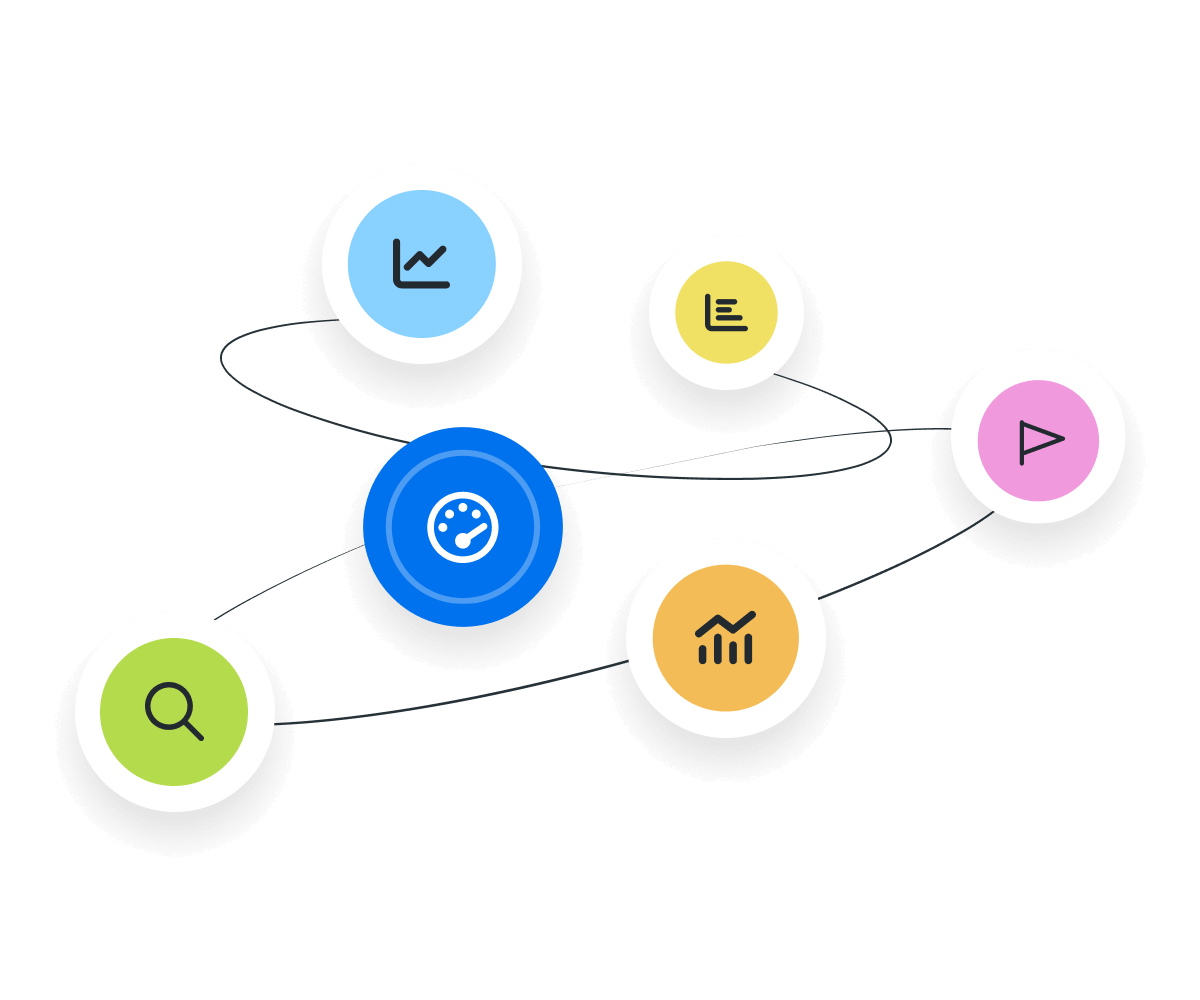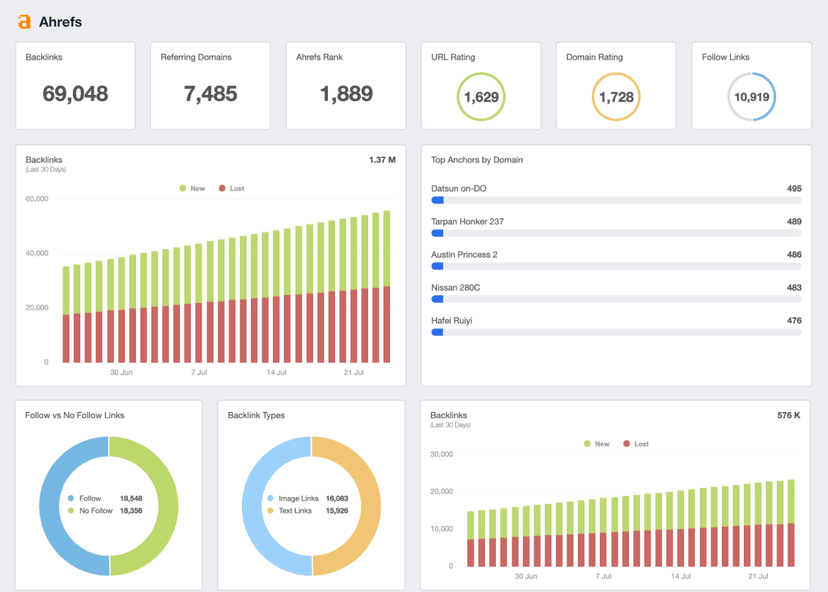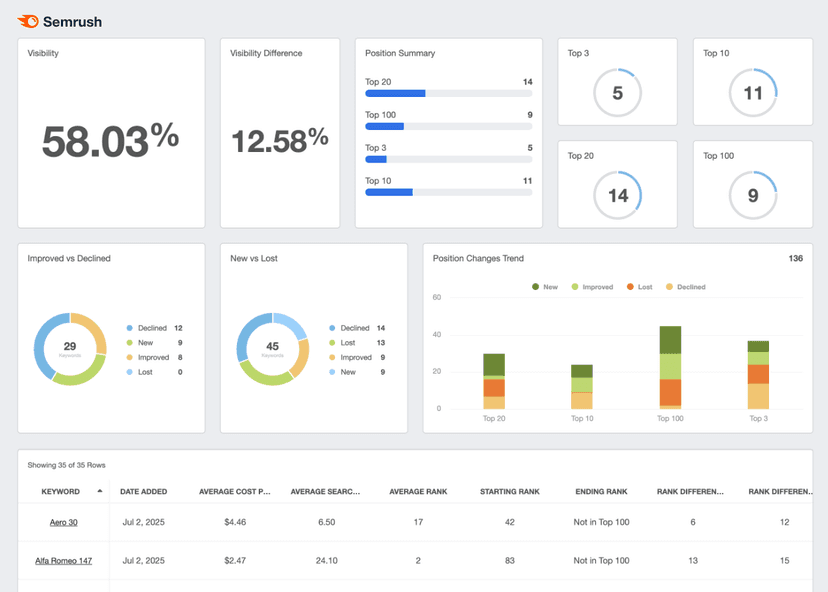Share of Voice
Competitor Benchmarking
Assess your brand's measures of visibility compared to competitors and gain insights into your competitive metrics.
Audience Reach Analysis
Assess how effectively the brand engages the target audience on major social networks.
Market Positioning
Evaluate your brand's presence and standing in the market to adjust brand messaging for marketing channels accordingly.
Content Impact Evaluation
Track the performance of your content strategy across channels to refine messaging across marketing efforts.
Why Share of Voice Is Important
Calculating Share of Voice (SOV) is critical to understanding how often a brand appears in its market compared to its competitors. It indicates how effectively the brand reaches its intended audience. By tracking social media mentions on major social media platforms and performing sentiment analysis, this KPI helps pinpoint areas where a brand leads or falls behind in market presence.

Stop Wasting Time on Reports. Get Marketing Insights in Minutes With AgencyAnalytics.
How Share of Voice Relates To Other KPIs
Marketing metrics like Engagement Rate and Brand Awareness complement SOV to highlight how effectively a brand’s visibility connects with its audience. A strong SOV paired with a high Engagement Rate signals that a brand consistently captures attention. PPC share KPIs such as Cost per Acquisition (CPA) and Return on Ad Spend (ROAS) also complement SOV to reveal how well a brand turns its presence into valuable business outcomes.
When you measure Share of Voice alongside these marketing metrics, you help clients allocate budgets more strategically. You also help your agency optimize client marketing campaigns for maximum conversion potential and financial success.

Key Factors That Impact Share of Voice
Several elements influence SOV. Budget allocation is a primary driver since spending more on paid advertising increases brand visibility. Quality of content creation and publishing frequency also play a role. Brands that consistently produce high-quality, engaging content typically secure more frequent brand mentions on social media accounts. Competitor activity is another influencing factor. A brand’s relative market share may decrease when competitors enhance their marketing efforts.

How To Calculate Share of Voice
Calculate Share of Voice by dividing the brand's total mentions or impressions by the total across all competitors and multiplying by 100 to receive a percentage.
Share of Voice Formula Example
What Is a Good Share of Voice?
High SOV signals market authority and strong brand recall, often translating into higher customer engagement and loyalty. It generally indicates that a brand commands a visible and competitive presence in its market.
While specific targets vary by industry, a Share of Voice Percentage between 25-30% is often considered strong.
What Is a Bad Share of Voice?
A low SOV suggests a brand may struggle to capture attention compared to its competitors.
Typically, an SOV below 10% indicates limited visibility. This signals the need to adjust a digital marketing strategy to improve competitive positioning.
How To Set Share of Voice Benchmarks and Goals
Establish visibility targets for clients by analyzing historical data and industry standards. Reviewing past SOV provides a baseline, while industry averages offer reference points to match or exceed competitors. Aligning these benchmarks with business goals ensures that SOV objectives drive brand growth effectively.
Why Share of Voice Matters to Clients
For clients, SOV is a valuable indicator of how effectively their brand stands out in a crowded market. This metric reveals how often the brand appears on the same social media platforms as competitors, offering insight into its relative market power. Clients appreciate SOV as a tangible measure of their brand's growth and influence.

Why Share of Voice Matters to Agencies
As for your agency, using SOV demonstrates the success and impact of your marketing strategies. A high SOV affirms your agency’s ability to deliver value in a competitive environment. SOV is also a critical measure to help you refine current and future campaigns for engagement and conversion effectiveness.

Discover the All-in-One Reporting Tool Trusted by 7,000+ Marketing Agencies
Best Practices When Analyzing and Reporting on Share of Voice
Conducting a detailed SOV analysis across various lenses strengthens campaign effectiveness and enhances competitive insights.
Ensure Data Accuracy
Use the right share of voice tools, such as social listening tools, to track consistent data across social media and digital marketing platforms.
Analyze Over Time
Use social media monitoring tools to track SOV trends like monthly search volume over time. This provides context on growth and highlights the impact of your campaigns.
Put in Context
Interpret trends and anomalies in SOV to identify areas of opportunity or concern. This allows for timely campaign adjustments.
Visualize Performance
Use clear visuals to help clients understand SOV results in the context of competitors. Visualizations make reports easier for clients to understand.
Align To Client Goals
Align Share of Voice metrics to specific client goals to reassure clients that all marketing efforts will translate into outcomes that clients value.
Include Actionable Recommendations
Include actionable recommendations within your SOV reports to guide clients on your next steps and make results more impactful.
FAQs About Share of Voice
Still have questions about Share of Voice? Don’t worry—we’ve got you covered.
Share of Voice in digital marketing tracks how often a brand appears across marketing channels compared to competitors. It measures brand mentions, impressions, and visibility to show the brand’s market presence and competitive standing.
Share of Voice is important because it shows how effectively a brand captures audience attention. Tracking it helps identify where a brand leads or lags in visibility, allowing marketers to adjust campaigns for better reach and performance.
Share of Voice works with KPIs like Engagement Rate and Brand Awareness to show how visibility turns into attention. It also complements PPC metrics like CPA and ROAS to connect visibility with actual business outcomes.
Share of Voice is influenced by ad spend, content quality, publishing frequency, and competitor activity. Brands that publish consistently and respond to competitor moves typically gain more visibility.
Share of Voice is valuable to clients because it reveals how often their brand is seen in the market compared to competitors. It’s a concrete way to measure visibility, brand impact, and marketing success over time.
Digital Marketing Dashboard Example

How To Improve Share of Voice
Below are three actionable tips to enhance SOV across marketing channels.
Focus on Content Quality
Focus on creating high-quality content with relevant keywords to improve organic search rankings. Engaging, relevant content attracts organic social media mentions, increasing brand visibility naturally.
Monitor Competitor Activity
Stay informed on competitor marketing campaigns and social media presence. Monitor competitor ad space and social media share to adjust your SEO strategy.
Leverage Influencers and Partnerships
Collaborate with influencers to tap into new audience demographics and improve your brand's position.
Related Blog Posts
See how 7,000+ marketing agencies help clients win
Free 14-day trial. No credit card required.










